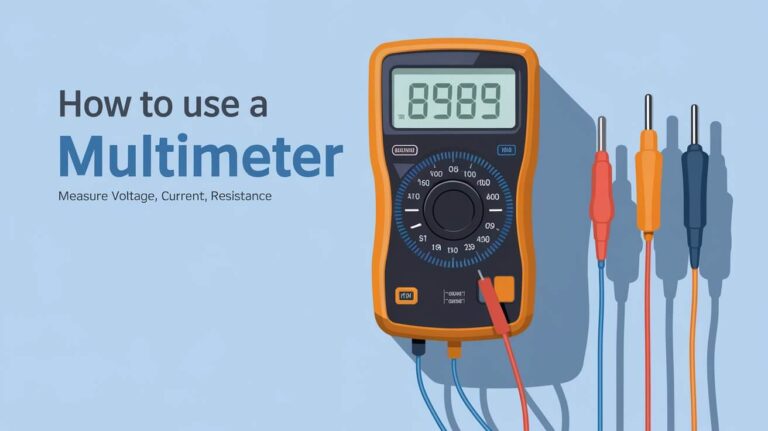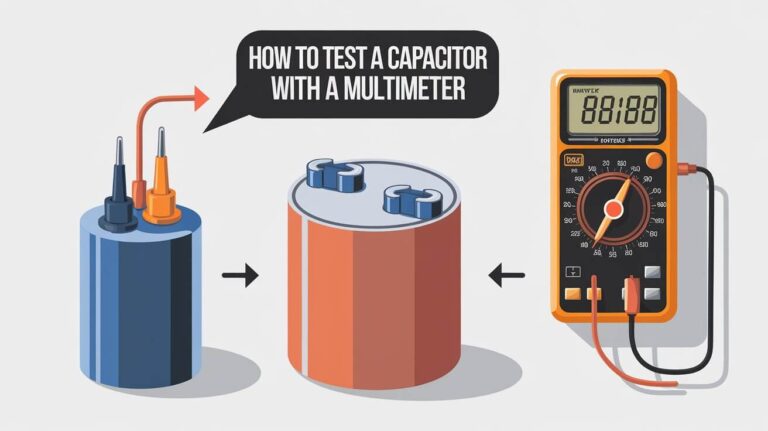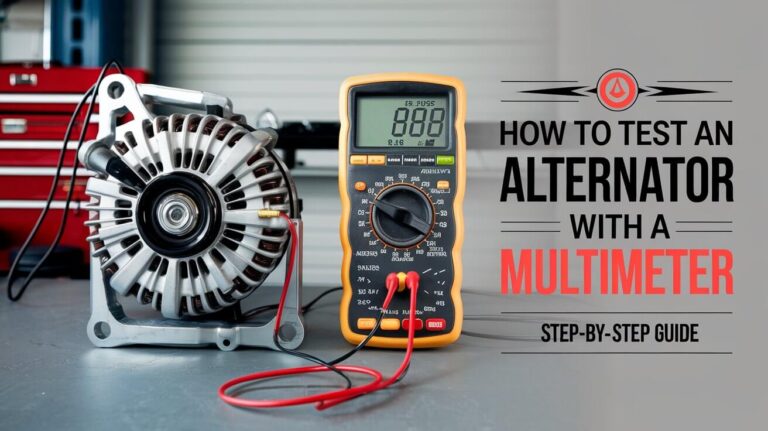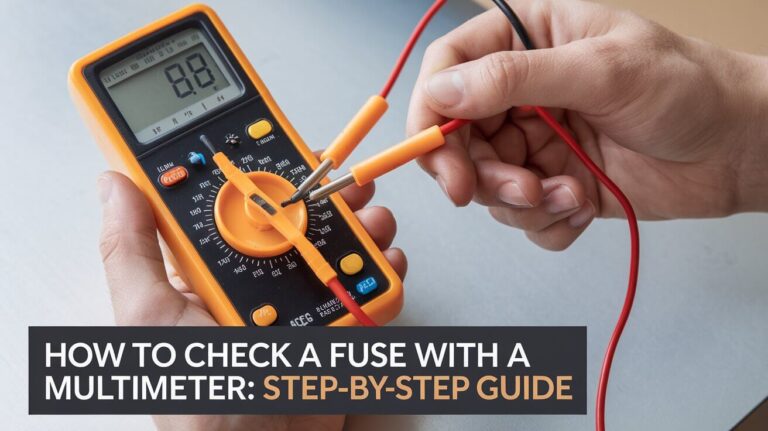How to Check Car Battery with Multimeter: A Complete Guide

Car batteries are essential to ensuring your vehicle starts and runs smoothly. If your car battery is weak or faulty, it can lead to frustrating breakdowns. Fortunately, you can easily check the condition of your battery with a multimeter. In this comprehensive guide, you’ll learn step-by-step how to check a car battery with a multimeter, understand the readings, and maintain your battery to ensure its longevity.
Tools and Preparations Before Checking Your Car Battery
Before diving into the steps of testing your car battery, it’s important to gather the necessary tools and prepare your vehicle properly. Here’s what you’ll need and some essential steps to follow before you begin.
What You’ll Need:
- Multimeter: A multimeter is a versatile tool that measures electrical voltage, current, and resistance. For this task, we’ll use the multimeter to measure DC voltage.
- Gloves and Safety Goggles: For your safety, especially when handling car batteries.
- Cleaning Tools: A wire brush, baking soda, and water are useful for cleaning corroded battery terminals.
Important Safety Precautions
Working with car batteries can be dangerous if done improperly. Follow these steps to ensure your safety:
- Turn Off the Car: Always make sure the car engine is off before testing the battery. Turn off any accessories like the radio, lights, and air conditioning as well.
- Wear Protective Gear: Use gloves and goggles to protect yourself from potential battery acid exposure.
- Ensure Ventilation: If you’re testing the battery in an enclosed area like a garage, open the doors or windows to ensure proper ventilation, as car batteries can emit dangerous gases such as hydrogen.
Step-by-Step Guide to Checking Your Car Battery with a Multimeter
Now that you’ve gathered the necessary tools and ensured your safety, it’s time to test your car battery with a multimeter. Follow these simple steps to get an accurate reading.
Step 1: Locate and Prepare the Battery
Start by locating your car’s battery. In most cars, the battery is under the hood, but in some models, it may be in the trunk or under the back seat. If you’re unsure where your battery is located, consult your vehicle’s owner manual.
Cleaning the Battery Terminals
Corrosion on battery terminals can affect the accuracy of your multimeter readings. If you see any corrosion, clean the terminals using a wire brush. You can also use a solution of baking soda and water to neutralize any acid buildup. Make sure to dry the terminals thoroughly before proceeding.
Step 2: Setting Up the Multimeter
Next, you’ll need to set up the multimeter correctly. Here’s how to do it:
- Select DC Voltage Mode: Set your multimeter to DC voltage mode. This is usually marked with a “V” and a straight line or a dashed line.
- Set the Voltage Range: Turn the dial to 20V to ensure the reading will cover the typical car battery range of 12-14V.
Step 3: Testing the Battery Voltage
Now that your multimeter is set, you’re ready to test the battery.
- Connect the Probes: Attach the red probe to the battery’s positive terminal (+) and the black probe to the negative terminal (-).
- Check the Reading: Look at the display on your multimeter. A fully charged car battery should read about 12.6V or higher. A reading between 12.4V and 12.6V indicates that the battery is still in good condition but may need charging soon. Anything below 12.0V means the battery is likely discharged or damaged and might need replacing.
Understanding Voltage Readings and What They Indicate
Once you have your voltage reading, it’s essential to understand what the numbers mean. Here’s a quick guide to help you interpret your results.
Battery Health by Voltage
- 12.6V or Higher: Your battery is fully charged and in good condition.
- 12.4V – 12.6V: The battery is moderately charged, and you may want to recharge it soon.
- 12.0V – 12.3V: Your battery is undercharged and may need attention. Consider recharging or replacing it if the problem persists.
- Below 12.0V: This indicates a potentially dead or faulty battery that needs immediate attention.
Common Voltage Issues
If your battery voltage falls below 12V, it may be due to:
- Old Age: Batteries typically last 3-5 years, and performance declines over time.
- Parasitic Draw: Accessories or lights left on can drain your battery when the car is off.
- Faulty Alternator: A malfunctioning alternator can fail to charge the battery properly, resulting in low voltage.
Advanced Testing Methods for Car Batteries
While checking the voltage is a good indicator of battery health, there are more advanced ways to test your battery’s performance and condition.
Load Testing with a Multimeter
Load testing helps determine how your battery holds up under stress. To perform a load test:
- Set your multimeter to DC voltage.
- Turn on your car’s headlights for 2 minutes to place the battery under load.
- Then test the voltage as described earlier.
- If the voltage drops below 9.6V while under load, it’s a sign your battery is struggling and may need replacement.
Alternator Testing with a Multimeter
Your alternator plays a vital role in keeping your battery charged. You can also use a multimeter to check if your alternator is working properly:
- Start your car and set your multimeter to DC voltage.
- Attach the probes as before to the battery terminals.
- A healthy alternator should give a reading of 13.7V to 14.7V when the car is running. If your multimeter shows a lower voltage, your alternator may be failing.
What to Do If Your Car Battery Fails the Test
So, what happens if your battery reading is below the expected levels? Here’s what to do next:
Recharging the Battery
If your battery is reading low but not completely dead (i.e., between 12V – 12.4V), you can try recharging it.
- Driving for 30 Minutes: A long drive can sometimes help charge the battery if the alternator is working correctly.
- Using a Battery Charger: A battery charger can bring the voltage back up to healthy levels. However, avoid overcharging, as it can damage the battery.
When to Replace Your Car Battery
If your battery cannot hold a charge even after recharging, it may need to be replaced. Additionally, if your battery is more than 3-5 years old or you’ve noticed signs like dim headlights or slow engine cranks, it’s likely time for a replacement.
Tips for Maintaining Your Car Battery for Longevity
Regular maintenance is key to keeping your car battery in good shape and extending its life. Here are some tips to help maintain a healthy battery:
Routine Inspections
- Regularly check the battery terminals for corrosion or loose connections.
- Test the voltage periodically to catch any problems early.
Properly Clean Battery Terminals
Corroded terminals can cause poor connections, leading to charging issues. Here’s how to clean them:
- Turn off your car and remove the terminal covers.
- Loosen the clamps and clean the terminals using a wire brush.
- Apply a mixture of baking soda and water to neutralize any acid buildup.
- Rinse and dry the terminals, then reattach the clamps.
Prevent Overcharging
Overcharging can damage your battery and shorten its lifespan. If you’re using a battery charger, use one with a smart charging feature that automatically shuts off when the battery is fully charged.
Frequently Asked Questions About Car Battery Testing with a Multimeter
Can I Test My Battery Without Disconnecting It?
Yes, you can test the battery while it’s still connected to the car as long as the car and accessories are turned off.
How Can I Test a Car Battery That’s Not Connected to the Car?
The process is the same, except that you don’t need to worry about turning off the engine or accessories. Simply connect the probes and take the reading as usual.
What Does It Mean If My Multimeter Shows High Voltage?
High voltage readings (above 14.7V) while the car is running can indicate an overcharging issue, likely caused by a malfunctioning alternator. It’s best to get the charging system checked by a professional.
Troubleshooting Common Battery Testing Issues
If you’re experiencing issues while testing your battery, here are some common problems and how to fix them.
Low Voltage Reading
If you’re seeing a low voltage reading:
- Check the battery connections to ensure they are clean and tight.
- Recharge the battery if necessary.
- If the issue persists, check the alternator to ensure it’s charging the battery properly.
High Voltage Reading
If you’re getting a high voltage reading, there may be a problem with the charging system. An overcharging alternator can damage the battery and electrical components, so get this checked by a professional mechanic.
Consulting a Professional for More Accurate Testing
While a multimeter provides a good indication of battery health, there may be deeper issues at play. If your multimeter readings are unclear or your battery problems persist, consulting a professional mechanic can help. They have access to more specialized tools that can test the entire electrical system, including the alternator, starter, and wiring.
Conclusion
Regularly testing your car battery with a multimeter is a simple yet effective way to ensure your vehicle runs smoothly. By understanding how to read the voltage, perform load tests, and maintain your battery, you can avoid unexpected breakdowns and extend the life of your car’s battery. Remember to practice good battery maintenanceRegularly testing your car battery with a multimeter is a simple yet effective way to ensure your vehicle runs smoothly. By following the steps outlined, you can get an accurate reading of your battery’s voltage and detect any potential issues before they turn into costly repairs. Always remember to practice safety measures when handling car batteries, perform periodic checks, and maintain the battery to prolong its life.
If you experience consistent low readings or other electrical issues, it might be time to consult a professional mechanic for a more thorough diagnosis. Proper maintenance and timely tests can prevent sudden battery failures and keep your vehicle in top shape.




